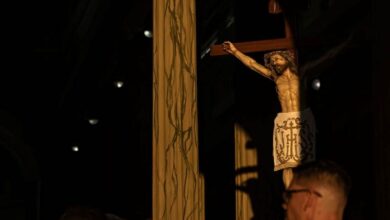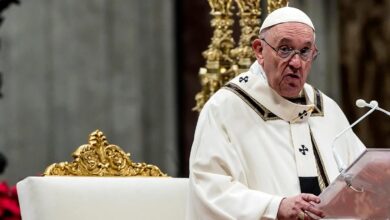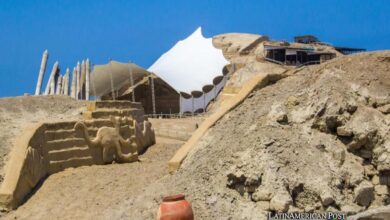What did Pope Francis achieve in his visit to Iraq?
The head of the Catholic Church made a historic visit to the Arab country with specific interests.

The trip of the Argentine Pope is framed in 3 main reasons: religious, diplomatic and humanitarian. Photo: Reuters
LatinAmerican Post | Santiago Gómez Hernández
Listen to this article
Leer en español: ¿Qué consiguió el papa francisco en su visita a Irak?
In the first week of March, Pope Francis made his first visit to Iraq. A country involved in a social conflict, mired in a crisis from which it has not yet been able to emerge when the United States and its allied troops entered in search of chemical weapons that they never found and overthrew the dictator Saddam Hussein. A once-powerful Arab nation that still maintains strong social divisions due to religious extremism between Shiites and Sunnis that also affects racial and religious minorities, such as the Christians of Iraq, one of the oldest Christian peoples in history.
The trip of the Argentine Pope is framed for 3 main reasons: religious, diplomatic, and humanitarian. All 3, also wrapped in a mystique and symbolism that characterize the visits of one of the Pope.
Also read: The Pope's trip to Iraq and municipal elections in Bolivia
El Papa Francisco y el principal clérigo chiita de Irak, el ayatolá Ali Al Sistani, se despiden tras reunirse el sábado en Nayaf pic.twitter.com/sXgWNkIyp1
— Reuters Latam (@ReutersLatam) March 7, 2021
Jorge Mario Bergoglio met with the main Shiite religious leader, Ayatollah Ali Al Sistani. This appointment had an important symbolic charge since the head of Catholicism traveled to the holy city of Najaf, the main religious center of this branch of Islam and a pilgrimage center for Shiites from all over the world. Thus giving a show of respect and coexistence in a predominantly Muslim country, but one that does not live under Sharia law.
This meeting between 2 of the most powerful men in the religious world is framed in a series of meetings that the Vatican has tried to hold with different religious leaders to promote religious respect and coexistence.
For example, in 2016, Francis met with Patriarch Kirill, leader of the Russian Orthodox Church. This meeting is classified as one of the most historic, as it brings together the leaders of the two main branches of Christianity between the East and the West. This meeting was seen as a first rapprochement between both branches of religion and as an opportunity to build bridges of communication.
El papa Francisco y el patriarca de la Iglesia ortodoxa rusa, Kiril, instan al diálogo en Siria para evitar un conflicto mundial.
https://t.co/PMeFvYrRsF pic.twitter.com/tuDsFHh16c— Última Hora (@UltimaHoracom) April 17, 2018
A humanitarian visit
Precisely, with the Russian patriarch, Francis spoke and they shared their mutual interest in the difficult situation faced by Christians in the Middle East, such as those who inhabit Iraq. Both religious leaders in 2016 found meeting points in improving the situation of Christians in the Middle East. This is why Francis has traveled to this country as an accolade to the Christian minority that has been one of the most affected and persecuted since the creation of the Islamic State. For example, from the BBC indicate that since the US invasion of Iraq in 2003 and until 2019, the Iraqi Christian community was reduced by 83%
Support for the current government
Despite his spiritual and religious role, Francis serves as the head of the Vatican State. His arrival in Iraq is also an accolade to Prime Minister Mustafa Al-Kadhimi since for many years the Popes have not been able to travel to Iraq for security reasons (John Paul II had already tried).
This was also evidenced in the Pope's speech on Iraqi unity. The pontiff did not differentiate between citizens of different religions but encouraged the union of peoples under a single flag, that of Iraq. This is a sign of the intention of the Holy See to support an inclusive Government that can guarantee the well-being of all citizens, regardless of their religion.
Clear support for a government that is still under construction and very weakened by the constant attacks of extremist movements that seek to divide the country.
Esta hermosa cruz fue hecha con madera recuperada entre los restos de una iglesia incendiada por el Estado Islámico en Karemlesh. Este domingo acompañará al Papa Francisco en su paso por Mosul, Irak. #PopeInIraq #PopeFrancisInIraq @SakerAlzakarai 1/3 pic.twitter.com/Pu8hRUEArt
— ACI Prensa (@aciprensa) March 6, 2021
Precisely, adding to the symbolic acts, the Pope prayed before a crus in the city of Mosul, not far from the same place where, seven years earlier, Abu Bakr al Baghdadi proclaimed the caliphate of the Islamic State (IS) from the mosque of Al Nuri. Evidence of the new Iraq, which seeks to pass the chapter of terror left by the IS.




